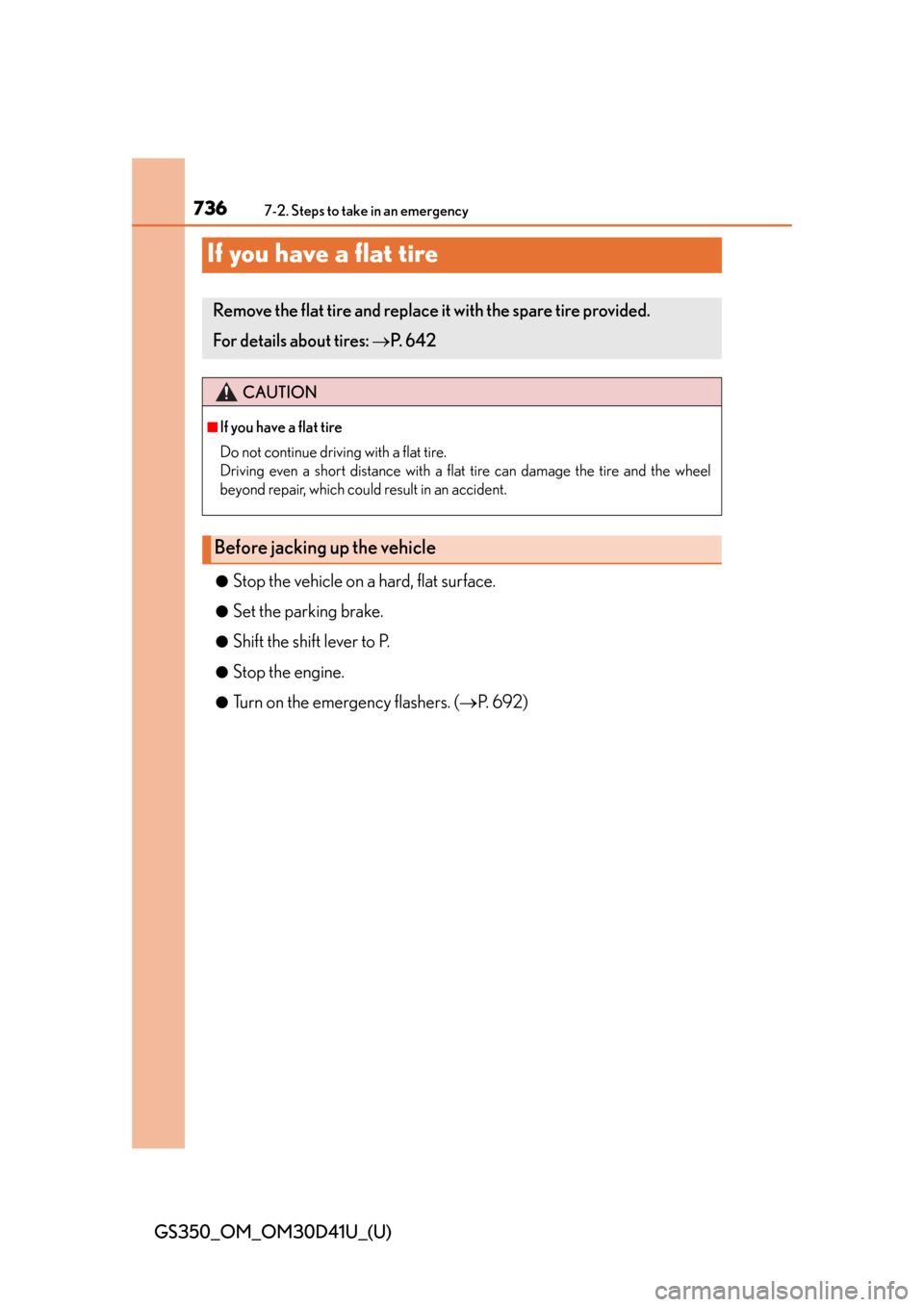tires Lexus GS350 2014 Using the air conditioning system and defogger / LEXUS 2014 GS350 (OM30D41U) Owner's Guide
[x] Cancel search | Manufacturer: LEXUS, Model Year: 2014, Model line: GS350, Model: Lexus GS350 2014Pages: 844, PDF Size: 10.59 MB
Page 710 of 844

7107-2. Steps to take in an emergency
GS350_OM_OM30D41U_(U)
CAUTION
■Maintenance of the tires
Each tire, including the spare (if provided), should be checked monthly when cold
and inflated to the inflation pressure re commended by the vehicle manufacturer on
the vehicle placard or tire inflation pressu re label (tire and load information label).
(If your vehicle has tires of a different size than the size indicated on the vehicle
placard or tire inflation pressure label [t ire and load information label], you should
determine the proper tire inflation pressure for those tires.)
As an added safety feature, your vehicle has been equipped with a tire pressure
monitoring system (TPMS-tire pressure wa rning system) that illuminates a low tire
pressure telltale (tire pressure warning light ) when one or more of your tires is sig-
nificantly under-inflated. Accordingly, when the low tire pressure telltale (tire pres-
sure warning light) illuminates, you should stop and check your tires as soon as
possible, and inflate them to the proper pressure. Driving on a significantly under-
inflated tire causes the tire to overheat and can lead to tire failure. Under-inflation
also reduces fuel efficiency and tire tread life, and may affect the vehicle’s handling
and stopping ability.
Please note that the TPMS (tire pressure warning system) is not a substitute for
proper tire maintenance, and it is the driver’s responsibility to maintain correct tire
pressure, even if under-inflation has not re ached the level to trigger illumination of
the TPMS low tire pressure telltale (tire pressure warning light).
Your vehicle has also been equipped with a TPMS (tire pressure warning system)
malfunction indicator to indicate when th e system is not operating properly. The
TPMS (tire pressure warning system) malfunction indicator is combined with the
low tire pressure telltale (tire pressure warning light). When the system detects a
malfunction, the telltale will flash for approximately one minute and then remain
continuously illuminated. This sequence will continue upon subsequent vehicle
start-ups as long as the malfunction exists . When the malfunction indicator is illumi-
nated, the system may not be able to detect or signal low tire pressure as intended.
Page 711 of 844

7117-2. Steps to take in an emergency
GS350_OM_OM30D41U_(U)
7
When trouble arises
CAUTION
TPMS (tire pressure warning system) malfunctions may occur for a variety of rea-
sons, including the installation of replacement or alternate tires or wheels on the
vehicle that prevent the TPMS (tire pressure warning system) from functioning
properly. Always check the TPMS (tire pressure warning system) malfunction tell-
tale after replacing one or more tires or wheels on your vehicle to ensure that the
replacement or alternate tires and wheels allow the TPMS (tire pressure warning
system) to continue to function properly.
NOTICE
■Precaution when installing a different tire
When differently constructed tires or tires of different makers, models or tread pat-
terns are installed, the tire pressure warning system may not operate properly.
Page 736 of 844

736
GS350_OM_OM30D41U_(U)
7-2. Steps to take in an emergency
If you have a flat tire
●Stop the vehicle on a hard, flat surface.
●Set the parking brake.
●Shift the shift lever to P.
●Stop the engine.
●Turn on the emergency flashers. (P. 6 9 2 )
Remove the flat tire and replace it with the spare tire provided.
For details about tires: P. 6 4 2
CAUTION
■If you have a flat tire
Do not continue driving with a flat tire.
Driving even a short distance with a flat tire can damage the tire and the wheel
beyond repair, which could result in an accident.
Before jacking up the vehicle
Page 738 of 844

7387-2. Steps to take in an emergency
GS350_OM_OM30D41U_(U)
CAUTION
■Using the tire jack
Observe the following precautions.
Improper use of the tire jack may cause the vehicle to suddenly fall off the jack,
leading to death or serious injury.
●Do not use the tire jack for any purpose other than replacing tires or installing and
removing tire chains.
●Only use the tire jack that comes with this vehicle for replacing a flat tire.
Do not use it on other vehicles, and do not use other tire jacks for replacing tires
on this vehicle.
●Put the jack properly in its jack point.
●Do not put any part of your body under the vehicle while it is supported by the
jack.
●Do not start the engine or drive the vehicle while the vehicle is supported by the
jack.
●Do not raise the vehicle while someone is inside.
●When raising the vehicle, do not put an object on or under the jack.
●Do not raise the vehicle to a height greater than that required to replace the tire.
●Use a jack stand if it is necessary to get under the vehicle.
●When lowering the vehicle, make sure that there is no-one near the vehicle. If
there are people nearby, warn them vocally before lowering.
Page 741 of 844

7417-2. Steps to take in an emergency
GS350_OM_OM30D41U_(U)
7
When trouble arises
Chock the tires.
Slightly loosen the wheel nuts
(one turn).
Turn the tire jack portion “A” by
hand until the notch of the jack is
in contact with the jack point.
The jack point guides are located
under the rocker panel. They indicate
the jack point positions.
Replacing a flat tire
1
Flat tireWheel chock positions
FrontLeft-hand sideBehind the rear right-hand side tire
Right-hand sideBehind the rear left-hand side tire
RearLeft-hand sideIn front of the front right-hand side tire
Right-hand sideIn front of the fron t left-hand side tire
2
3
Page 746 of 844

7467-2. Steps to take in an emergency
GS350_OM_OM30D41U_(U)
■The compact spare tire
●The compact spare tire is identified by the label “TEMPORARY USE ONLY” on
the tire sidewall.
Use the compact spare tire temporarily, and only in an emergency.
●Make sure to check the tire inflation pressure of the compact spare tire.
( P. 775)
■When using the compact spare tire
As the compact spare tire is not equipped with a tire pressure warning valve and
transmitter, low inflation pressure of the spare tire will not be indicated by the tire
pressure warning system. Also, if you replace the compact spare tire after the tire
pressure warning light comes on, the light remains on.
■When the compact spare tire is equipped
The vehicle becomes lower when driving wi th the compact spare tire compared to
when driving with standard tires.
■If you have a flat rear tire on a road covered with snow or ice (vehicles with front
and rear tires of the same size)
Install the compact spare tire on one of th e front wheels of the vehicle. Perform the
following steps and fit tire chains to the rear tires:
Replace a front tire with the compact spare tire.
Replace the flat rear tire with the tire removed from the front of the vehicle.
Fit tire chains to the rear tires.
1
2
3
Page 748 of 844

7487-2. Steps to take in an emergency
GS350_OM_OM30D41U_(U)
CAUTION
■Speed limit when using the compact spare tire
Do not drive at speeds in excess of 50 mph (80 km/h) when a compact spare tire
is installed on the vehicle.
The compact spare tire is not designed for driving at high speeds. Failure to
observe this precaution may lead to an accident causing death or serious injury.
■After using the tools and jack
Before driving, make sure all the tools and jack are securely in place in their stor-
age location to reduce the possibility of pe rsonal injury during a collision or sudden
braking.
NOTICE
■Driving with tire chains and the compact spare tire
Do not fit tire chains to the compact spare tire.
Tire chains may damage the vehicle body and adversely affect driving perfor-
mance.
■When replacing the tires
When removing or fitting the wheels, tire s or the tire pressure warning valve and
transmitter, contact your Lexus dealer as the tire pressure warning valve and trans-
mitter may be damaged if not handled correctly.
Page 752 of 844

752
GS350_OM_OM30D41U_(U)
7-2. Steps to take in an emergency
If the parking brake cannot be released
●Shift the shift lever to P.
●Turn the engine switch off.
●Check that the parking brake indicator is off.
●Chock the tires.
Take out the parking brake
release tool and the screwdriver
from the trunk. (P. 7 3 7 )
Fit the parking brake release tool into
the screwdriver handle.
Take out the spare tire. ( P. 7 3 6 )
In the event that the battery is disc harged or switch operation does not
release the parking brake, the par king brake can be released manually
using the procedure belo w. This procedure should be performed only if
necessary, such as in an emergency.
If the switch cannot be operated ev en when the battery is normal, the
parking brake system may be malfunctioning. Have the vehicle
inspected by your Lexus dealer immediately.
Before releasing the parking brake manually
Releasing the parking brake manually
1
2
Page 753 of 844

7537-2. Steps to take in an emergency
GS350_OM_OM30D41U_(U)
7
When trouble arises
Remove the plug.
Insert the tool and press it down
firmly while turning it counter-
clockwise until it stops.
■Manual operation of the parking brake
The parking brake canno t be set manually.
3
4
CAUTION
■When releasing the parking brake manually
●Shift the shift lever to P, turn the engine switch off and chock the tires. Failure to
do so may cause the vehicle to move, resulting in an accident.
●Turn the engine switch off and check that the parking brake indicator is off. Failure
to do so may cause the system to oper ate and turn the inserted parking brake
release tool, resulting in an injury.
Page 764 of 844

764
GS350_OM_OM30D41U_(U)
7-2. Steps to take in an emergency
If the vehicle becomes stuck
Stop the engine. Set the parking brake and shift the shift lever to P.
Remove the mud, snow or sand from around the rear wheels.
Place wood, stones or some other material under the rear wheels to
help provide traction.
Restart the engine.
Shift the shift lever to D or R and release the parking brake. Then, while
exercising caution, depress the accelerator pedal.
■When it is difficult to free the vehicle
Carry out the following procedures if the tires spin or the vehicle
becomes stuck in mud, dirt or snow:
Press to turn off TRAC. ( P. 2 7 1 )
1
2
3
4
5